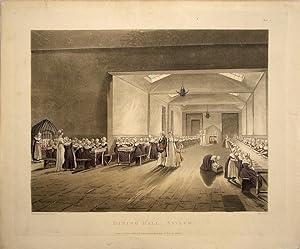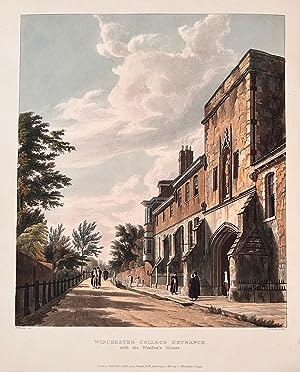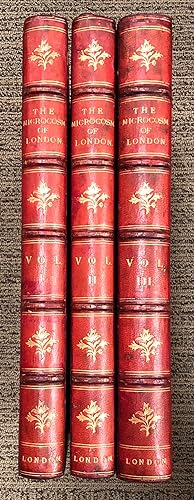Ackermann Rudolph Pugin Augustus Charles (3 results)
Product Type
- All Product Types
- Books (2)
- Magazines & Periodicals
- Comics
- Sheet Music
- Art, Prints & Posters (1)
- Photographs
- Maps
-
Manuscripts &
Paper Collectibles
Condition
- All Conditions
- New
- Used
Binding
- All Bindings
- Hardcover (1)
- Softcover
Collectible Attributes
- First Edition (1)
- Signed
- Dust Jacket
- Seller-Supplied Images
- Not Printed On Demand
Seller Location
Seller Rating
-
Lambeth. Asylum Dining Hall.
Publication Date: 1808
Seller: theoldmapman, Weston super Mare, United Kingdom
Art / Print / Poster
Single print. London. Original hand-coloured aquatint from The Microcosm of London by Rudolf Ackermann; the leading company for the production of aquatints early in the nineteenth century. Pictured here is the dining hall of Lambeth Asylum for Female Orphans or House of Refuge, in the early years of the 19th century. The institution was founded in 1758 by magistrate John Fielding as a means to protect young orphaned and often impoverished girls from descending into a life of vice. A few closed short edge tears outside the plate mark will be hidden by a mount. £65-£95 generally asked for this print. 33 x 27 cm.
-
History of the Colleges of Winchester, Eton, and Westminster, The
Published by London: Printed for and Published by R. Ackermann, 1816, 1816
Seller: David Brass Rare Books, Inc., Calabasas, CA, U.S.A.
First Edition
"Highest Praise" For Ackermann's Colleges "Equals, If Not Surpasses, That of Oxford and Cambridge" [ACKERMANN, Rudolph, publisher]. The History of the Colleges of Winchester, Eton, and Westminster; with the Charter-House, the Schools of St. Paul's, Merchant Taylors, Harrow, and Rugby, and the Free-School of Christ's Hospital. London: Printed for and Published by R. Ackermann, 1816. First edition, early issue. Large quarto (13 3/8 x 11 1/8 inches; 340 x 282 mm.). vi, [1, "Arrangement of Plates"], [1, blank], 56; 72; 27, [1, blank]; 32; 34; 22; 40; 34; 43, [1, blank] pp. With forty-eight hand-colored plates (forty-five aquatint and three engraved), including four costume plates and forty-four views by Havell, Stadler, Bluck, and others, after Westall, Mackenzie, Pugin, and others. All plates with tissue guards. Text watermarked 1816, plates watermarked 1812 and 1816. Abbey's second state of Plate 6 ("Winchester College, from the Meadow"), dated "Jany. 1, 1816"; Abbey's second state of Plate 23 ("Westminster School Room"), with hats added to the masters; Abbey's second state of Plate 26 ("Charter House, from the Play Ground"), depicting thirteen boys and masters playing cricket (instead of washerwomen). Handsomely bound ca. 1940 by Birdsall of Northampton & London (stamp-signed in gilt on lower front turn-in). Full red morocco, covers decoratively paneled and tooled in gilt. Spine with five raised bands decoratively ruled and lettered in gilt in compartments, decorative gilt board edges and turn-ins, cockerel endpapers, top edge gilt. Housed in a later leather-edged slipcase. A wonderful example - the plates with early watermarks, all clean and fresh with superb hand coloring. With the pencil marks of the late, great bookseller Charles W. Traylen of Guildford on the verso of the front free endpaper date "30. 11. 63" "[Ackermann's History of the University of Oxford (1813) and History of the University of Cambridge (1814)] were fittingly followed by a History of the Colleges.Of this also a thousand copies were issued in monthly parts, the first appearing on January 1, 1816.The text, with the exception of the parts dealing with Winchester, Eton, and Harrow (the work of W.H. Pyne), were entirely written by Combe, and the same artists were employed in its decoration, the highest praise for which is that it equals, if not surpasses, that of Oxford and Cambridge. The original drawings for the forty-eight coloured plates were distributed among Westall, who executed fifteen, and Pugin and Mackenzie, who did fourteen each, while one is by J. Gendall, who besides illustrating Ackermann's publications was employed for some years in managing his business, particularly in developing the new art of lithography. The actual engraving was done by Havell and Stadler, with a few plates by Bluck and Bennett, and four line engravings of costume by Agar after Uwins. Here again it may be noticed that many of the aquatints are printed in two colours before being finished by hand" (Martin Hardie). The roots of Birdsall of Northampton "stretch back to the early eighteenth century but it was in 1792 that John Lacy's Northampton bindery was acquired by William Birdsall, continuing in his family until 1961.In Birdsall's heyday, Gerring (Notes on Bookbinding, 1899) reported a staff of 250 engaged in making ladies handbags, fancy boxes, and stationary; as well as all types of bookbinding. The firm seemed always ready to experiment and careful records and samples were kept by Richard Birdsall, great-great-nephew of the founder, until he died in 1909.The firm's collection of over 3,000 finishing tools passed to the University of Toronto" (Maggs, Bookbinding in the British Isles II, #262, and #321). "Birdsall's is notable for the high quality of their leathers and finishings, as well as for the inventive style of their 'inlaid pictorial bindings'" (Chevalier Collection, Christie's November 9, 1990). Abbey, Scenery, 440; Adams, London Illustrated, 116; Martin Hard.
-
The Microcosm of London, or London in Miniature
Published by R. Ackermann, London, 1808
Seller: Argosy Book Store, ABAA, ILAB, New York, NY, U.S.A.
hardcover. Condition: near fine. Thomas Rowlandson & Augustus Charles Pugin (illustrator). First. Beautifully illustrated with 104 brilliantly hand-colored aquatint plates after Thomas Rowlandson and A.C. Pugin [Pugin engraved the architectural details & Rowlandson the figures]. 3 volumes. Illustrated woodcut titles and engraved dedication page to the Prince of Wales in each volume. [4], iv, [2], 231; [6], vi, 239; [4], iv, 280, [6] pages. Large 4tos, bound in contemporary 3/4 red calf over marbled boards with gilt spines; marbled endpapers; all edges yellow. London: R. Ackermann, 1808-1810. First edition, likely bound from the original parts, without the half titles as was often the case; the papers are watermarked 1806 & 1807 and containing 11 of Abbey's 12 key plates are in the first "luminescent" state, and 12 of the 13 errata points still un-corrected. Offsetting from plates as usual, and dedication pages are foxed, but otherwise an exceptionally clean and bright copy with very infrequent spotting in margins on a handful of pages. Rowlandson's first and most famous color-plate book, increasingly difficult to obtain in early state, as so many copies were broken up to sell the images individually. Ackermann is credited with establishing art lithography in England and this is one of his most interesting and valuable works. "The Microcosm of London is one of the great colour-plate books, and a carefully selected copy should form the cornerstone of any collection of books on this subject. The plates present an unrivaled picture of London in the early 19th century, of historic value, as many of the buildings no longer exist." --Tooley 7. "Original impressions of these splendid plates have a luminous quality entirely absent from later printings". --Abbey Scenery 212.




